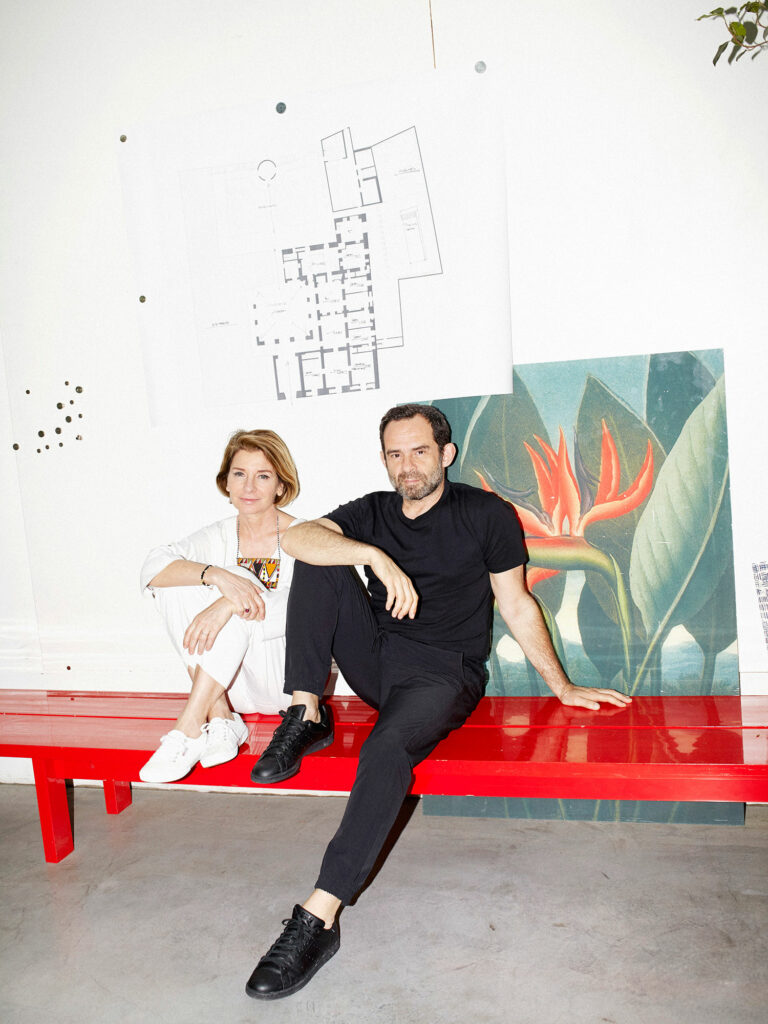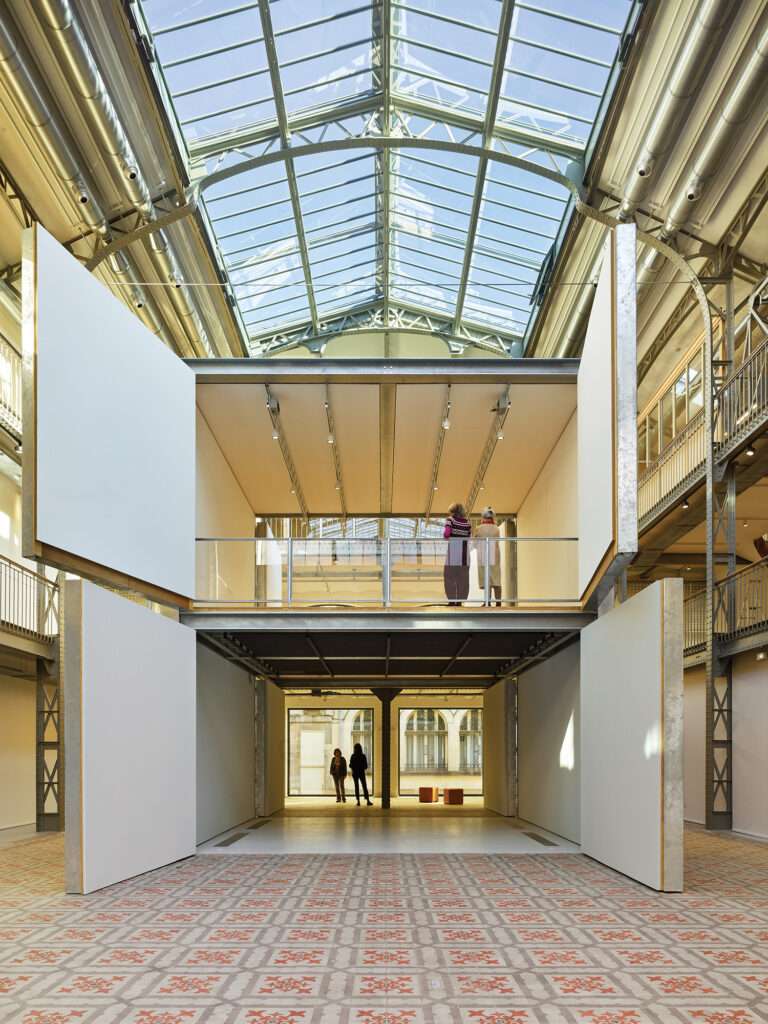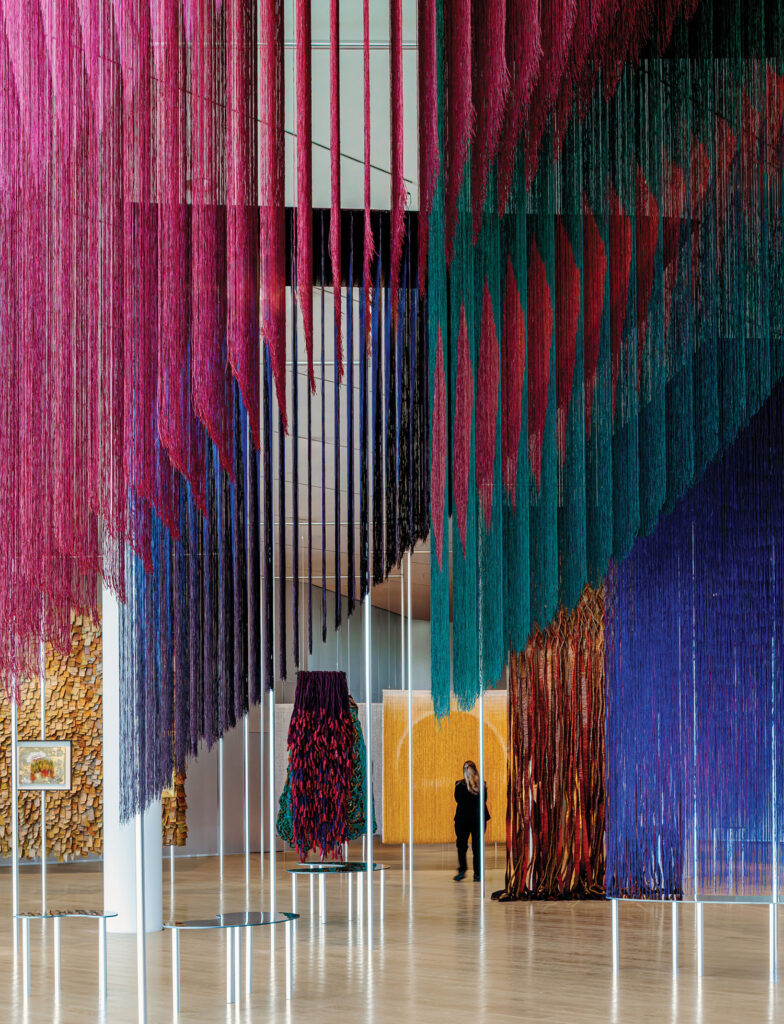10 Questions With… Roberto Palomba and Ludovica Serafini
Roberto Palomba and Ludovica Serafini are partners in work and life, but share a single (and singular) vision. After founding Palomba Serafini Associati in 1994, they developed a body of work for an astonishing number of clients, from early Foscarini lighting and Flaminia bathroom products through collaborations with Kos, Laufen, Zucchetti, CC Tapis, Talenti, Kartell, and dozens more; at this year’s Salone, they debuted some 17 new products. No matter the project, their work remains distinctive, melding rigorous historical sensitivity to an inherent respect for pushing boundaries. Over the decades, Palomba and Serafini have established themselves as restless legends, staying busy while staying true to their core values.
The dynamic duo recently sat for a Zoom and discussed their blockbuster year, how design shouldn’t be like a cocktail, and building souls for their projects.
How Roberto Palomba and Ludovica Serafini Create Spaces With Soul
Interior Design: How did you first meet?
Roberto Palomba: We met a million years ago at a Julius Caesar party. I was flirting with Cleopatra, and I fell in love with her completely. It was natural because we are both architects. We studied together, and we started to cooperate on projects together. It was very simple, and here we are after 30 years.

Ludovica Serafini: When you are young, you both have the same tastes even if you have different experiences. So it’s quite natural to share the same dreams. After so many years, we still share the same vision. We want to innovate, not to change things or shock people, but just for the sake of innovation. We don’t want to live in the comfort zone.
ID: What were those early days of the firm like?
RP: In the beginning, we were working on small projects with small brands. But then, we started to be conscious about the quality that we worked with. We began designing bathroom products and some of those innovations remain as the standard worldwide. It was crazy. We started from a design vision plus an architectural vision.
LS: Another important part of our job was always thinking about sustainability in design. From the beginning, we were using sustainable materials. The second product we designed was a recycled aluminum table. And this year, we designed a huge table for Kartell also using recycled aluminum with a recyclable ceramic slab as a top. You can lacquer the aluminum and glaze the top the same color.
RP: It’s not a matter of using a green coat. We just designed a shower with brass made of more than 80% recyclable aluminum. We’re also using fabric made from plastic from the oceans, and we know where it’s coming from. When we first started, bathrooms were not at all designed by designers—even the journalists didn’t want to publish our designs. They don’t publish toilets! And then a few years later they said, “This is amazing!”


ID: Speaking of Kartell, when did you start working with them?I
RP: It’s been more than ten years. I had met Mr. Claudio Luti in Moscow and said I would like to work with you. I’m very shy and never do this, but Kartell is a very important brand, with an industrial vision that’s close to how we think. They said no thanks because they already had designers. But after a couple weeks Mr. Luti called us back and said I know you’re great in bathrooms, how could I expand my business in bathrooms? I said that you need some confidence; you can’t just make things just using plastic. We designed something using ceramic, and some years we used metalwork, which was super successful. The collections for Kartell were challenging, but they were great. And this year, we’ve made a little sofa. It’s a love story.
LS: The relationship with brands is not just a matter of sharing design, it’s becoming a family. We talk to them almost every day. The ideas don’t just come from a brief; they come from a discussion.
RP: The idea to share a vision with the designer and the designer to not think they are God—it’s an intimate connection where it is not my design or theirs, but ours.
ID: And what do you do when you both disagree with each other?
RP: We fight for five minutes and then she makes the decision. She’s the boss.
LS: That’s not true!
RP: The only real problem now is time. Sometimes when we have no time, I don’t want to say you’re nervous, but you have to be quick in arguing and solving. But this is good! Being a male and being a female is good because we give two different sides of the coin. And our studio has a lot of young people with interesting viewpoints to share.


ID: What was the brief for the LA ROQQA project?
LS: It was very difficult! The owner was very specific about the project. Creating a hotel experience today is not just about making a nice hotel—the problem was finding out what to add and what to take out, because an experience is made from a balance of adding and removing.
RP: Today, boutique hotels have become showrooms. It’s like grabbing a shaker, putting in some design and making a cocktail—this could be a daiquiri or a vodka-tonic, and you just substitute the name of a designer. But it’s not a matter of how you shake together some goods. It’s about how you make the experience, which depends on the nature of the building and the countryside.
LS: When you’re working with an existing building, you have to create a new dream and a new function. When you’re renovating a house, it’s different because it’s already a house. But here you are giving it a new soul.
RP: You can see when a place has or does not have a personality—whether it’s a showroom or design—since what they are missing is a soul. When Café Cost was destroyed, we missed a moment of the history. Public spaces like Cipriani should be kept as a heritage landmark.
LS: We have to behave like we’re creating a movie and put all these elements together, not just for decoration.
ID: How do you create a space with a soul?
RP: By studying the bones and the body. It’s like Frankenstein’s Monster.
LS: When you’re designing a hotel, it’s a place and a building; it’s historical and contemporary. You have to know what kind of people the place is for.
RP: We design for the people who are going to use it. When we design a table, we think about how it’s made, what it costs, and how it will be used. So, we start with the body and then we add the electricity—that is our competence in putting together what we’ve learned. We have so many chairs and so many hotels, so why do something new? The reason is only to be better, which means the new place will have a soul.


ID: What is the soul of the Casa Piana project?
LS: It’s not a precious building, but it’s in Salento and the soul of that place is the materials and the light.
RP: It’s a place between two seas, and like all the places between two seas, there is a special reflection of light. It’s very important.
LS: There were some historical elements that are very nice so we kept it, like some of the wood. In this region, the problem in a building is that is has to be protected from the light.
RP: You arrive at the top of a staircase in a small courtyard with a structure with an iron frame; it was very basic but crafty. Though it was not as unique, it was precious, so we kept it. Houses have a special roof on the top, and we put in a kitchen there.
ID: How did you decide what kind of a life should be on the roof, and what should be below?
RP: Design always starts from the people who are going to live there. Food in Salento is basic, but the kitchen is the core of the house. In the summertime, you don’t cook since it’s too hot. But in the evening, everyone stays on the roof and cooks together. This is the job of the architect, to understand where the life goes and the flow that makes the life easy.


ID: What is flowing down the pipeline for you?
RP: We just had 17 launches at Salone… I’m very happy about the outdoor collection we designed for Talenti. And we worked on a collection with Fendi Casa for a few years, working with the colors and materials.
LS: We were working with DNA of that brand, in which the structure of a sofa was not made of standard cushions and did not just look like their bags translated into a sofa.
RP: Sometimes the fashion brands are too connected and we don’t see that as good design—like a shoe becomes a cabinet. This is a pattern we see everywhere. But we need good furniture that brings the brand’s values into real design. A chair is a chair and has to respect the laws of a chair. So when you design for Poltrona Frau, it’s different from Zanotta. The brands have their own values. You have to use their values as an ally, not as an enemy.
ID: And how is your summer looking?
LS: I will be exploring Sicily.
RP: I will be waiting for her in our home in Salento, sleeping and eating a lot and getting large like a cow!
read more
DesignWire
A Contemporary Art Center Blooms Inside An 1893 Eiffel-Style Icon
Jakob+MacFarlane reimagines a historic textile warehouse as Frac-Artothèque Nouvelle-Aquitaine, a 21,000-square-foot contemporary art center.
DesignWire
10 Questions With… Chris Gustin
Ceramic artist Chris Gustin dives into the dynamic exploration of movement and nature in his largescale works and his show at the Donzella gallery.
DesignWire
A Career In Color: Explore Olga De Amaral’s Retrospective In Miami
Explore a different perspective on color with textile artist’s Olga De Amaral’s retrospective at the Institute of Contemporary Art, Miami.


